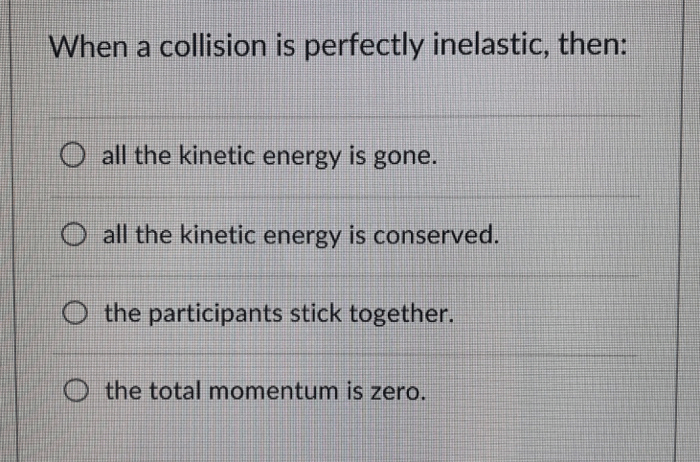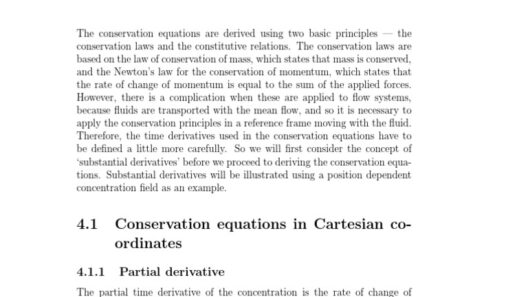When it comes to the dynamics of collisional interactions among objects, a question often arises: Is kinetic energy conserved in a perfectly inelastic collision? This inquiry opens a gateway into the intricate world of physics, where forces, motion, and energy dance together in accordance with the laws of nature. To navigate this realm effectively, we must first delineate what a perfectly inelastic collision is.
A perfectly inelastic collision is characterized by the maximum degree of deformation upon impact. In such collisions, two bodies collide and stick together post-collision, moving as a single entity. This scenario engenders an interesting phenomenon—while momentum remains conserved, kinetic energy does not share the same fate. But why is this the case?
To elucidate this transformation, we must draw attention to the principle of conservation of momentum. In any collision, whether elastic or inelastic, the total momentum of the system before and after the interaction remains constant. Mathematically, this can be expressed with the equation: m₁v₁ + m₂v₂ = (m₁ + m₂)v_f, where m represents mass, v signifies velocity, and v_f is the final velocity post-collision. This elegant relationship allows for the calculation of the final velocity of the combined mass after the impact.
However, when we consider kinetic energy, the situation becomes considerably more complex. Kinetic energy is defined by the formula K.E. = ½ mv². Thus, in a perfectly inelastic collision, the pre-collision kinetic energies of the two bodies—expressed as K.E._1 + K.E._2—is typically greater than the kinetic energy of the combined mass after the collision: K.E._f = ½ (m₁ + m₂)(v_f)². The disparity between these energies highlights an essential principle of inelastic collisions: although momentum is conserved, kinetic energy is transformed into other forms of energy such as heat, sound, or the energy required to deform the colliding objects.
Consider the playful scenario of two clay blobs colliding and merging into one. As they collide, they emit a soft squishing sound, which illustrates the energy transformation. The kinetic energy that was initially present in the motion of the clay is not lost but rather redistributed and dissipated in various forms. This example serves as an accessible metaphor to foster our understanding of the underlying mechanics of perfectly inelastic collisions, where motion yields to an amalgamation of forces.
Now, let us probe deeper into the consequences of this phenomenon. When kinetic energy is not conserved, it raises intriguing questions about energy efficiency and conservation in broader contexts. By examining elastic and inelastic collisions, we can glean insights regarding energy transfer and loss within systems. In most real-world applications—automobile safety features, for instance—understanding the nuances of kinetic energy during a collision is vital for designing effective crumple zones, airbags, and other safety measures. Such considerations underscore the importance of kinetic energy’s transformation during perfectly inelastic collisions, as they present both potential hazards and avenues for innovation in safety technology.
As we further explore the implications, it is essential to appreciate how the concept of conservation of energy extends beyond mere collisions. The interplay of kinetic energy within a system has far-reaching ramifications in the contexts of thermodynamics and mechanical systems, where energy efficiency is paramount. For example, wind turbines harness kinetic energy from moving air and transform it into electrical energy, illustrating a key principle: while the form of energy that is utilized may change, the total energy within the system is conserved.
Moreover, it is prudent to consider the broader ecological implications. The transition from kinetic energy to other forms during a perfectly inelastic collision serves as a reminder of the inherent inefficiencies present in many systems. In terms of sustainability and environmental consciousness, reducing energy dissipation in various processes is critical. By gaining a robust understanding of energy transformations, industries can seek innovative strategies to minimize energy loss and promote conservation efforts.
In conclusion, the question of whether kinetic energy is conserved in a perfectly inelastic collision has profound implications. The affirmation that kinetic energy is not conserved underlines a fundamental truth in physics—the transformation and dissipation of energy are as vital to understanding motion as the conservation of momentum. As we navigate through playful quizzes and serious inquiries alike, we unearth layers of complexity that challenge our perception of energy conservation while informing the design of safer, more efficient systems. In this way, our journey through collisions not only enriches our grasp of the physical world but also invites the contemplation of optimal energy practices in our quest for sustainability.







